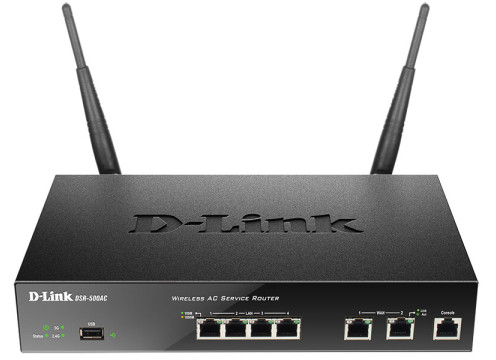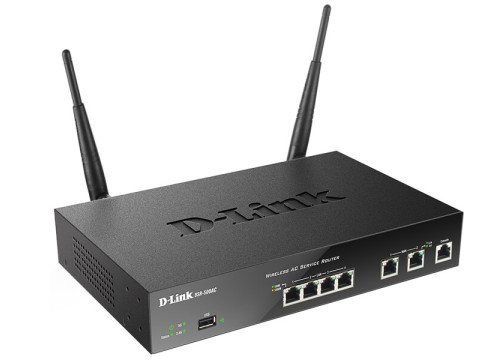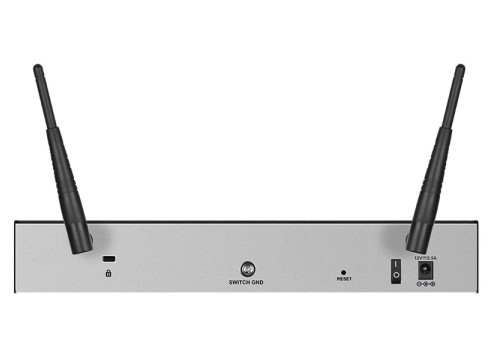





D-Link VPN Wireless Business router 2X WAN, 4X GBL AC1200 Dual Band
מק"ט:
אחריות:
יצרן:
מפרט
חיבור אלחוטי
חיבור WAN
מספר יציאות
מהירות מבואות
מידע
Interfaces
• Two WAN port 10/100/1000Base-T
• Four LAN ports 10/100/1000Base-T
• 802.11a / b / g / n / ac
• One USB 2.0 port
• Console port with RJ-45
Indicators
• Power / Status
• WLAN 2.4GHz / 5GHz
• USB
• LAN / WAN (Speed / Status)
Buttons
• Reset button
Antenna
• Two removable omnidirectional antenna with a gain of 2 dBi
Power connector
• Power connector (DC)
Performance
Bandwidth Firewall
• 950 Mbit / s
Bandwidth VPN
• 200 Mbit / s
Number of concurrent sessions
• 50,000
Number of new sessions per second
• 500
Firewall Policy
• 600
Wireless
Standards
• IEEE 802.11a / b / g / n / ac
Frequency Range
• 802.11b / g / n: from 2.4 GHz to 2.483 GHz
• 802.11a / n / ac: from 5.18 GHz to 5.825 GHz
Wireless Security
• Wired Equivalent Privacy (WEP)
• Wi-Fi Protected Setup (WPS)
• Wi-Fi Protected Access - Personal (WPA-PSK)
• Wi-Fi Protected Access - Enterprise (WPA-EAP)
• Wi-Fi Protected Access version 2 - Personal (WPA-PSK)
• Wi-Fi Protected Access version 2 - Enterprise (WPA-EAP)
• Multiple SSID of the wireless network (SSID)
• Service Set Identifier (SSID) to VLAN Mapping
Wireless speed
• IEEE 802.11a: 6, 9, 12, 18, 24, 36, 48 and 54 Mbit / s
• IEEE 802.11b: 1, 2, 5.5 and 11 Mbit / s
• IEEE 802.11g: 6, 9, 12, 18, 24, 36, 48 and 54 Mbit / s
• IEEE 802.11n (2,4 GHz) of 6.5 to 300 Mbit / s
• IEEE 802.11n (5 GHz): 6.5 to 150 Mbit / s
• IEEE 802.11ac: from 7.2 to 1300 Mbit / s
Transmitter output power
Maximum transmit power will vary according to the rules of radio frequency regulation in your country.
• IEEE 802.11a: 14 dBm at 6 ~ 54 Mbit / s
• IEEE 802.11b: 18 dBm at 1 ~ 11 Mbit / s
• IEEE 802.11g: 11 dBm at 6 ~ 54 Mbit / s
• IEEE 802.11n: 10 ~ 6 dBm at 300 Mbit / s (2.4 GHz) 14 ~ 6 dBm at 150 Mbit / s (5 GHz)
• IEEE 802.11ac: 11 dBm at 7.2 ~ 1300 Mbit / s
Receiver Sensitivity
• IEEE 802.11a:
-82 DBm at 6 Mbit / s
-81 DBm at 9 Mbit / s
-79 DBm at 12 Mbits / s
-77 DBm at 18 Mbit / s
-74 DBm at 24 Mbits / s
-70 DBm at 36 Mbit / s
-66 DBm at 48 Mbit / s
-65 DBm at 54 Mbit / s
• IEEE 802.11b:
-89 DBm at 2 Mbit / s
-83 DBm at 11 Mbit / s
• IEEE 802.11g:
-82 DBm at 6 Mbit / s
-81 DBm at 9 Mbit / s
-79 DBm at 12 Mbits / s
-77 DBm at 18 Mbit / s
-74 DBm at 24 Mbits / s
-70 DBm at 36 Mbit / s
-66 DBm at 48 Mbit / s
-65 DBm at 54 Mbit / s
• IEEE 802.11n:2.4 GHz / HT-20:
-82 DBm at MCS0 / 8/16
-79 DBm at MCS1 / 9/17
-77 DBm at MCS2 / 10/18
-74 DBm at MCS3 / 11/19
MCS4 at -70 dBm / 12/20
-66 DBm at MCS5 / 13/21
-65 DBm at MCS6 / 14/22
-64 DBm at MCS7 / 15/23
2.4 GHz / HT-40:
-79 DBm at MCS0 / 8/16
-76 DBm at MCS1 / 9/17
-74 DBm at MCS2 / 10/18
-71 DBm at MCS3 / 11/19
MCS4 at -67 dBm / 12/20
-63 DBm at MCS5 / 13/21
-62 DBm at MCS6 / 14/22
-61 DBm at MCS7 / 15/23
5GHz / HT-20:
-82 DBm at MCS0
-79 DBm at MCS1
-77 DBm at MCS2
-74 DBm at MCS3
-70 DBm at MCS4
-66 DBm at MCS5
-65 DBm at MCS6
-64 DBm at MCS7
5GHz / HT-40:
-79 DBm at MCS0
-76 DBm at MCS1
-74 DBm at MCS2
-71 DBm at MCS3
-67 DBm at MCS4
-63 DBm at MCS5
-62 DBm at MCS6
-61 DBm at MCS7
• IEEE 802.11ac:VHT-20:
-82 DBm at MCS0
-79 DBm at MCS1
-77 DBm at MCS2
-74 DBm at MCS3
-70 DBm at MCS4
-66 DBm at MCS5
-65 DBm at MCS6
-64 DBm at MCS7
-59 DBm at MCS8
-57 DBm at MCS9
VHT-40:
-79 DBm at MCS0
-76 DBm at MCS1
-74 DBm at MCS2
-71 DBm at MCS3
-67 DBm at MCS4
-63 DBm at MCS5
-62 DBm at MCS6
-61 DBm at MCS7
-56 DBm at MCS8
-54 DBm at MCS9
VHT-80:
-76 DBm at MCS0
-73 DBm at MCS1
-71 DBm at MCS2
-68 DBm at MCS3
-64 DBm at MCS4
-60 DBm at MCS5
-59 DBm at MCS6
-58 DBm at MCS7
-53 DBm at MCS8
-51 DBm at MCS9
Type of Internet connection
• Static / Dynamic IP-address
• PPPoE / L2TP / PPTP
• Multiple PPPoE
Firewall
• Static route
• Dynamic Route: RIP v1 / v2, OSPF, OSPFv3
• Dynamic DNS
• Inter-VLAN Routing
• NAT, PAT
• Web-content filtering, static URL-address, keywords, Dynamic WCF (license required)
• Intrusion Prevention System (IPS): package signatures, the supplied software
• Authentication: internal database, RADIUS, POP3, LDAP, AD, NT Domain
Network Features
• DHCP Server / Client
• DHCP Relay
• IEEE 802.11q VLAN
• VLAN (port-based)
• IP Multicast: IGMP Proxy, IGMP Snooping
• IPv6
• Auto switch between WAN-connections after a failure (Route Failover)
• Load Balancing (Outbound Load Balancing)
• Redundancy 3G / 4G2
Virtual Private Network (VPN)
• VPN-tunnels: 95
• IPSec-tunnel: 35
• PPTP / L2TP-tunnels: 25
• GRE-tunnels: 15
• Encryption methods: DES, NULL
• Server IPSec / PPTP / L2TP
• IPSec NAT Traversal
• Detection of non-performing nodes
• IP Encapsulating Security Payload (ESP)
• IP Authentication Header (AH)
• VPN Tunnel Keep Alive
• Hub and Spoke
Bandwidth Management
• Management of the maximum bandwidth
• Manage bandwidth priority:
- QoS Port-based
- Class 3
System Management
• Web-interface
• Command line
• SNMP v1, v2c, v3
Comprehensive Management Capabilities
The DSR-500/500AC and DSR-1000/1000AC Unified Services Routers include dual WAN Gigabit Ethernet ports to provide high availability for your WAN or Internet connections. Traffic can be load-balanced across the links with Outbound Load Balancing, increasing the performance and availability of business applications. The secondary WAN port can also be used to create a DMZ, isolating servers from your LAN. The DSR series supports mobile broadband networks via an extendable USB modem*, such as 3G or 4G** dongles. Traffic load balancing can be performed on the mobile data connections, providing an additional layer of redundancy for critical or backup applications.
Web Authentication Capabilities
Captive Portal allows employees and guest users to be easily authenticated and authorized by accessing a customized landing page. Users can be authenticated by a local database, RADIUS, LDAP, Microsoft Windows Active Directory, NT Domain and POP3 server. A maximum of four servers can be configured at any one time.
Complete and Robust VPN Features Web Content Filtering
A fully featured virtual private network (VPN) provides your mobile workers The DSR series also and branch offices with a secure link to your network. The DSR series routers administrators are capable of Generic web content filtering Routing Encapsulation (GRE) tunnels, empowering your mobile users by ActiveX, and cookies, or to providing remote access to a central corporate database. Site-to-site VPN filtering, which tunnels use IP Security (IPSec) Protocol, Point-to-Point Tunneling Protocol content from a list (PPTP), or Layer 2 Tunneling Protocol (L2TP) to facilitate branch office URLs and real-time connectivity through encrypted virtual links.
Web Content Filtering
The DSR series also provides a web content filtering feature to help administrators monitor, manage and control employees’ Internet usage. Static web content filtering helps to remove malicious objects such as Java applets, ActiveX, and cookies, or to block URLs by keyword. Dynamic web content filtering, which requires a license subscription, allows administrators to filter content from a list of categories. Multiple global index servers, with millions of URLs and real-time website data, enhance performance and maximize service availability.

